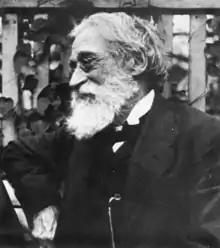Franz Steindachner
Franz Steindachner (11 November 1834 in Vienna – 10 December 1919 in Vienna) was an Austrian zoologist, ichthyologist, and herpetologist. He published over 200 papers on fishes and over 50 papers on reptiles and amphibians[1] Steindachner described hundreds of new species of fish and dozens of new amphibians and reptiles.[2] At least seven species of reptile have been named after him.[3]

Work and career
Being interested in natural history, Steindachner took up the study of fossil fishes on the recommendation of his friend Eduard Suess (1831-1914). In 1860 he was appointed to the position of director of the fish collection at the Naturhistorisches Museum, a position which had remained vacant since the death of Johann Jakob Heckel (1790-1857).[4]
Steindachner's reputation as an ichthyologist grew, and in 1868 he was invited by Louis Agassiz (1807-1873) to accept a position at the Museum of Comparative Zoology at Harvard University. Steindachner took part in the Hassler Expedition of 1871–1872 (a journey that circumnavigated South America from Boston to San Francisco). In 1874 he returned to Vienna, and in 1887 was appointed director of the zoological department of the Naturhistorisches Museum. In 1898 he was promoted to director of the museum.[4]
He traveled extensively during his career, his research trips taking him throughout the Iberian Peninsula, the Red Sea, the Canary Islands, Senegal, Latin America, et al. In his zoological studies, his interests were mainly from a systematic and faunistic standpoint.[5]
Among his better known works in ichthyology are Ichthyologische Notizen (1863, published over 8 editions), Ichthyologische Beiträge (1874), and Beiträge zur Kenntniss der Flussfische Sudamerikas (1879), the latter work dealing with river fish of South America. In the field of herpetology, he published Die schlangen und eidechsen der Galapagos-inseln (Snakes and lizards of the Galapagos Islands, 1875).[6]
From 1875, he was member of the Vienna Academy of Sciences. In 1892 he became a member of the German Academy of Sciences Leopoldina.[7]
Tributes
- Steindachneria, a fish genus of the western Atlantic;[8] (Steindachneria argentea, commonly known as the luminous hake).
- Steindachneridion, a genus of fish in South America discovered by Steindachner, is named after him.[9]
- Steindachnerina, a genus of fish in South America.[10]
Steindachner is commemorated in the scientific names of many species of fish: the characin from the Amazon River basin Leptagoniates steindachneri, a combtooth blennie from the Western Indian Ocean Istiblennius_steindachneri, a Mexican Cichlid Nosferatu steindachneri, the characin from Peru and Brazil Bario_steindachneri, a pomfret Taractichthys steindachneri, an upside down catfish Synodontis steindachneri from Africa, a thorny catfish from the Amazon Trachydoras steindachneri, a barb from the Cameroons Labeobarbus steindachneri, the north east Asian Phoxinus steindachneri, the cyprinid Raiamas steindachneri, the Golden Cownosed ray Rhinoptera steindachneri, Steindachner's sea catfish Cathorops steindachneri, the Brown Speckled Morey eel Gymnothorax steindachneri, the characin from the Amazon and Orinoco Gnathocharax steindachneri, the Redhump Eartheater Geophagus steindachneri a cichlid from Northeast South America, the Iberian peninsula Luciobarbus steindachneri, the blennie from the Eastern Pacific Ophioblennius steindachneri, the drum Cynoscion steindachneri, the Loricariid Hypoptopoma steindachneri, the chere-chere grunt Haemulon steindachneri, the drum Umbrina steindachneri and the south American Headstander Hypomasticus steindachneri.
Steindachner is also commemorated in the scientific names of reptiles: the worm lizard from South America Amphisbaena steindachneri, a long necked turtle from Australia Chelodina steindachneri, the gecko from Australia Lucasium steindachneri, the Florida mud turtle Kinosternon steindachneri, the skink from New Caledonia Lioscincus steindachneri, the snake Micrurus steindachneri, the wattle-necked softshell turtle Palea steindachneri from China and Southeast Asia, the lizard Phrynocephalus steindachneri (synonym of Phrynocephalus przewalskii), and the snake found in the Galapagos Pseudalsophis steindachneri.[11]
Birds named after Steindachner include the Speckle-chested piculet Picumnus steindachneri and a subspecies of Australasian pipit, Anthus novaeseelandiae steindachner from the Antipodes Islands.
Amphibians named after Steindachner include the African Frog Hyperolius steindachneri and a toad found throughout sub tropical Africa Sclerophrys steindachneri.
An Arachnids named after Steindachner is Aphonopelma steindachneri, a spider from the area of Southern California to Baja California.
Insects named after Steindachner include the Mexican Bumblebee Bombus steindachneri, a katydid found through out North America Neduba steindachneri, the beetle from Europe Stenomax steindachneri and the moth Copiopteryx steindachneri.
The sea slug Onchidella steindachneri is named after Steindachner.
The squid Abralia steindachneri is named after Steindachner.
The fish parasite Ceratothoa steindachneri is named after Steindachner.
References
- Kähsbauer P (1959). "Intendant Dr. Franz Steindachner, sein Leben und Werk ". Ann. Naturhist. Mus. Wien 63: 1-30. (in German).
- "Search results".
- "The Reptile Database".
- "Naturhistorisches Museum Wien". (in German).
- Killy, Walther; Vierhaus, Rudolf (2011-11-30). Schmidt - Theyer. ISBN 9783110966299.
- "Steindachner, Franz 1834-1919".
- Killy, Walther; Vierhaus, Rudolf (2011-11-30). Schmidt - Theyer. ISBN 9783110966299.
- Jordan DS, Evermann BW (1898). "The Fishes of North and Middle America: a Descriptive Catalogue ..." Bulletin of the United States National Museum. Number 47, Part III.
- http://www.fishbase.org/summary/48552.
- "Steindachnerina amazonica ". FishBase.
- Beolens, Bo; Watkins, Michael; Grayson, Michael (2011). The Eponym Dictionary of Reptiles. Baltimore: Johns Hopkins University Press. xiii + 296 pp. ISBN 978-1-4214-0135-5. ("Steindachner", p. 252).
Further reading
- Pietschmann V (1919). "Franz Steindachner ". Annalen des Naturhistorischen Museums in Wien 33: 47–48. (in German).
External links
- "The Herpetological Collection". Naturhistorisches Museum Wien. (in English).
- A selection of literature by Franz Steindachner: "Katalog der Deutschen Nationalbibliothek " (in German). German National Library. Archived from the original on 2016-03-04. Retrieved 2010-04-04.
- Biography in German @ Österreichisches Biographisches Lexikon 1815–1950 (ÖBL ).